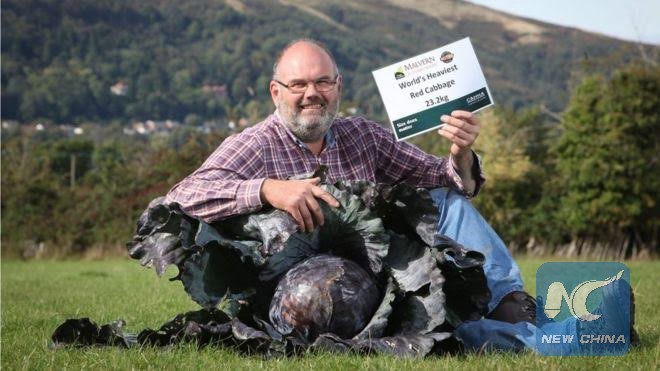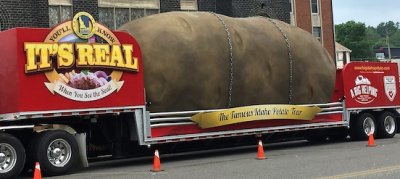Web posted Thursday, September 2, 2004
707-pound Nikiski pumpkin sets record
By JENNY NEYMAN
Peninsula Clarion
Driving by the front of the Tuboscope shop in Nikiski this summer, you'd never suspect anything unusual was tucked away behind the metal building off Old Nikiski Beach Road near the high school.
It would seem likely there would be the usual assortment of industrial-related items stashed out of view ‹ some tools; a forklift or two; maybe some scrap metal and a junk pile ‹ but certainly not what is likely to be the largest pumpkin in state history.
Yet that was home sweet home to a 707-pound giant gourd from the time it was planted in April until it was cut from its tangled sea of vines, loaded on a truck and taken to the Alaska State Fair in Palmer for a weigh-off Wednesday. As of 8:30 p.m. Wednesday, the pumpkin was by far and away the largest entered in the competition.
The proud papa to the amply-proportioned pumpkin is J.D. Megchelsen of Nikiski, a Tuboscope employee and gardener extraordinaire.
Megchelsen started nurturing his green thumb as a child, visiting his grandfather's farm in Iowa. He grew vegetables throughout his young life in New Mexico, then moved to Alaska after college and figured he'd have to scale back his gardening exploits due to the cold and short growing season. He certainly never imagined he'd be able to cultivate a pumpkin that would outweigh any in Alaska's history.
"People are amazed when they see it," Megchelsen said. "I see it myself all the time and I can hardly believe it."
Megchelsen got interested in growing mammoth pumpkins after seeing the success David Schroer of Homer had with them. Schroer set the previous state record for pumpkins in 1997 with a 347.01-pound specimen.
"He showed everybody else it's actually possible to grow stuff like this up here," Megchelsen said. "I would have never dreamed this is possible, myself. I'm indebted to him."
Megchelsen started growing pumpkins from store-bought seeds in five-gallon buckets three years ago. His biggest that year was 80 pounds. Last year he nursed a pumpkin along that reached 152 pounds. At that point, he decided to get serious. He stepped up his research, both in books and on the Internet. He got in touch with a giant pumpkin grower from Moose Jaw, Saskatchewan, Canada, who gave Megchelsen some Atlantic Giant pumpkin seeds that came from two of the largest pumpkins ever grown in the world.
Frank McAnally of Tuboscope indulged Megchelsen's flourishing hobby by letting him take over the back of the shop with homemade greenhouses (where he also grows tomatoes and giant cucumbers) and an automatic drip watering system.
To most people, the stretch of property between the building's back wall and the tree-covered hill about 50 feet beyond is nothing special. To Megchelsen it is gardening gold ‹ a perfect microclimate with the building blocking north winds, the hill blocking south winds and the open space in between perfectly aligned to the arch the sun traces across the sky.
Megchelsen mixed his own loam, rich with compost and a variety of nutrients. On April 7, he planted the seeds under a grow light. On April 27, he transplanted them into the greenhouse. Then the fun and real work began.
"It's tough to get one to this size," he said. "A lot of them will do themselves in."
In some respects, pumpkin growers in Alaska have it easy because the pests and plant viruses that plague growers in the Lower 48 don't exist up here.
"I had a moose come through once, but he didn't know what to make of it," Megchelsen said.
Megchelsen said he doesn't have any secrets for producing such vast vegetables. Just watering with warm water, using a good mix of compost soil and fertilizer and exercising basic gardening knowledge goes a long way, he said. Beyond that, it's been a process of trial and error.
"The best way to find out is just to grow one yourself," he said.
The main challenges growers here face are cold and the short growing season, Megchelsen said, but this summer was an exception to most with its record-breaking heat and low rainfall.
Though summer growing conditions did help, Megchelsen still had to put in a lot of effort ‹ usually about two to three hours a day before and after work and on his lunch break. Pumpkins have to be kept off the ground and rotated from the stem, he said. He buried the vines where roots sprouted so the plant got more nutrients. Pumpkin stems constantly crack and heal, but you have to be careful that no cracks or holes form on the pumpkin itself or it is ineligible for judging, he said. The pumpkin plant needed to be watered twice a day ‹ consuming 60 to 80 gallons of water most days and up to 100 gallons on hot days.
"These guys will eat anything you throw at them," Megchelsen said. "They're voracious eaters. You just about can't over-fertilize them. They just keep eating."
Then there's the problems that arise when pumpkins have minds of their own. Megchelsen said pumpkins develop personalities. As such, he gives them names. This year, two pumpkins made it to maturity.
Boxy ‹ so named for its somewhat square shape ‹ is the "little" one, weighing in at 504 pounds. Boxy was always well-behaved and didn't give Megchelsen any trouble. In fact, he (Megchelsen uses male pronouns when referring to the pumpkins) has a tenacious spirit, growing to several hundred pounds even though his vine cracked and didn't allow him to get full access to nutrients.
"I've got a lot of admiration for this little pumpkin here," Megchelsen said. "He did all this on a broken vine."
Then there's big brother, who was not so easy to care for.
Meet Thunderhorse ‹ 3 feet tall, 4 feet wide and 707 pounds with a light orange, cantaloupe-textured rind. The man from Moose Jaw who gave Megchelsen the seeds said growing a large pumpkin is like trying to ride a wild horse. Megchelsen experienced firsthand what the man meant and named the pumpkin in honor of the battle.
"It was literally a different problem every day," he said "... If you don't like problems, don't try and grow one of these guys."
Thunderhorse didn't start out as auspiciously as his name implies. At first he was the runt of the seeds Megchelsen planted. At one point he dug it up to see if it was even sprouting after the other seeds had broken above the dirt. He planted it anyway and it began to take off so fast that Megchelsen pollinated it with the other pumpkins, then killed all but Boxy off to give Thunderhorse room to grow.
"I came back the next morning and said, 'My God,'" Megchelsen said. "It went from (the size of an) orange to grapefruit to volleyball to basketball that quick, by the day."
The pumpkin's largest weight gain in one day was 9 pounds ‹ from 22 to 31 pounds. The next day it was 38 pounds and the next it was more than 41 pounds.
Thunderhorse spent most of his life outside the main greenhouse, not in exile, but because he refused to grow where Megchelsen wanted him to. He was growing against the greenhouse wall and continued to do so no matter how many times Megchelsen staked and repositioned him. Megchelsen finally cut a hole in the greenhouse wall, propped Thunderhorse off the ground outside the greenhouse and built him a warming shack complete with a little heater to keep him warm on cooler nights.
"They have their own will," he said. "I'm not sure who pushed who to the limit harder, me or the pumpkin."
By the time Megchelsen cut the pumpkin free of the rest of the plant Tuesday, the plant's main vine was about an inch in diameter and 45 feet long. With all the foliage, the entire plant weighed about a ton, Megchelsen estimated.
In a community as small as Nikiski, it's tough to keep a 700-plus pound pumpkin a secret for long. By the end of August, Megchelsen had to start scheduling visiting times because so many people were dropping by to see the plant, sometimes up to 40 or 50 a day, he said.
On Tuesday, a crowd of about 30 friends, family members and curious onlookers came to watch Thunderhorse and Boxy be loaded in Megchelsen's truck in preparation for their trip to the fair.
"Its exciting, especially to have it here in Nikiski," said Linda Spotts, a co-worker of Megchelsen's wife, Dana. "(Dana) has talked all about her husband, how important it's been to him and how he's just babied it. Even the whole (staff of) Tuboscope's been babying it. It's been a family project."
Megchelsen called in favors from about eight large Nikiski men to have them help lift the pumpkins onto palates that were loaded onto his truck with a forklift.
"There was enough people picking it up, it wasn't too bad," said Butch Ewing, operator at Tuboscope. "We've been looking at it all summer. I think it's amazing for something like that to grow up here."
The atmosphere at the loading took on a fair-like quality as people admired the size of the produce, kids gathered leaves and pieces of vine to take to school and almost everyone took turns posing for pictures with the pumpkins.
Through it all, Megchelsen bustled through the crowd, shaking hands, laughing at jokes and making sure his pumpkins were being safely transported. Thunderhorse had a special enclosure built around him for transport and was padded with foam, quilts and pillows. Boxy received somewhat second-class attention but still was padded, secured and handled with care.
Megchelsen was good-natured about the requests for pumpkin pie and jokes about how much care he's given the pumpkins.
"I wouldn't want to drive up behind him," Ewing said. "He'll probably drive 40 (miles per hour)."
Dana Megchelsen said she was excited for her husband and had hoped he would win.
"It's been his whole summer, and he loves it," she said. "He definitely has a green thumb, even at home."
Thunderhorse and Boxy will be on display at the state fair in Palmer until Monday.
Megchelsen said people do use giant pumpkins for pies and other edible endeavors, but he's not planning to do that. Last year he turned his biggest pumpkin into a jack-o'-lantern, but probably won't repeat that effort.
"They're so thick it's like chiseling a piece of granite," he said.
Megchelsen is working out a way to display the pumpkins in the central Kenai Peninsula after their duty at the state fair is done. After that, they'll go back in the compost pile to be recycled as food for next year's crop. But the memory of Boxy and Thunderhorse will live on, inspiring Megchelsen and several of his friends who have taken up gardening to try to grow even larger ones next summer. Megchelsen said getting other people interested in gardening is part of his reward for his record-setting pumpkin.
"If someone does grow a bigger one next year, I'll be the first one to want to see it," Megchelsen said.





